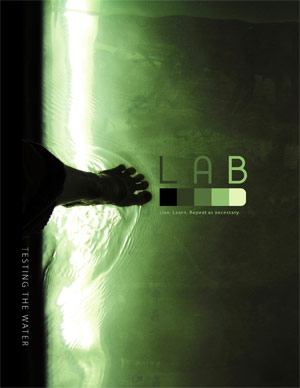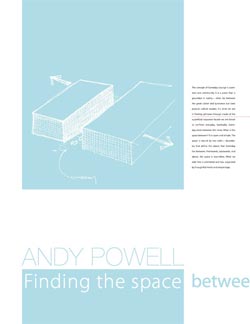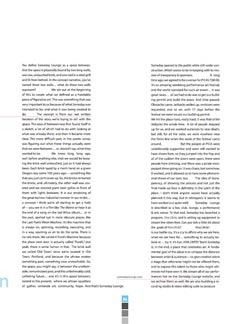From the Someday Lounge abstract:
The concept of Someday Lounge is openness and community. It is a place that is grounded in reality— what lies between the great clatter and ignorance our toxic popular culture exudes. It’s what we see in fleeting glimpses through cracks of the superficial corporate facade we are forced to confront everyday. Spiritually, Someday exists between this noise. What is this space between? It is open and simple. The space is bound by two walls— boundaries that define the places that Someday lies between. Frontwards, backwards, and above, the space is boundless. What we add here is elemental and raw, organized by thoughtful minds and simple logic.
You define Someday Lounge as a space between. And the space is physically bound by two long walls; one raw, untouched brick, and one clad in a steel grill and lit from behind. In the concept narrative, you’ve named these two walls… what do these two walls represent?
We set out at the beginning of this to create what we defined as a habitable piece of figurative art. This was something that was very important to us because of what Someday was intended to be, and what it was being created to do. The excerpt is from our last written iteration of the story we’re trying to tell with the space. The idea of betweenness first found itself in a sketch, a lot of which had to do with looking at what was already there, and then it became more clear. The more difficult part, in the poetic sense, was figuring out what these things actually were that we were between… or, should I say, what they wanted to be. We knew long, long ago, well before anything else, that we would be keeping the brick wall untouched, just as it had always been. Each brick layed by a man’s hand on a given Oregon day some 100 years ago— something like that you just can’t cover up. So, the bricks remained the bricks, and ultimately, the other wall was covered and we erected giant steel grilles in front of them with lights between. It is our rendering of the great techno-industrial monster in our midst… a concept I think we’re all starting to get a hold of— you see it in a film like The Matrix or hear it at the end of a song on the last Wilco album… or in the past, spelled out in more obscure places, like the Last Poets’ Mean Machine. It’s the machine that is always on, spinning, recording, executing, and in a way, spurring us on to do the same. There is no rest there. We called it ‘Ford’s Machine’ because the place next door is actually called “Ford’s,” and yeah, there is some humor in that. The brick wall we called ‘Old Town’, since we’re located in Old Town, Portland, and because the phrase evokes something past, something now unreachable. So, the space, you might say, is between the unattainable, romanticized past, and this unbelievably cold, unfeeling future… and it’s in this space between, rooted in the present, where we artisan squatters all gather, celebrate art, community, hope. And that’s Someday Lounge.
Someday opened to the public while still under construction. Which seems to be in keeping with its mission of transpareny & openness.
A long time ago, we agreed to be a venue for PICA’s T:BA 06. It’s an amazing weeklong performance art festival, and the world standard for such an event… it was great news… all we had to do was to get our building permit and build the place. And time passed. Obstacles came, setbacks added up, revisions were requested, and so on, until 17 days before the festival we were issued our building permit. We hit the place hard, really hard. It was Ride of the Valkyries the whole time. A lot of people stepped up for us, and we worked ourselves to near death, but still, for all the valor, we were nowhere near the finish line when the week of the festival came around. But the people at PICA were unbelievably supportive and were still excited to have shows here, so they jumped into the fray and all of the sudden the doors were open, there were people here drinking, and there was a pirate-rock-puppet show going on. It was chaos, but somehow, it worked, and it allowed us to have some phenomenal shows of our own, too. The idea of transparency, of showing the process and not just the final made-up face is definitely in the spirit of the place. I don’t think anyone would have actually planned it this way, but in retrospect, it seems to have worked out quite well.
Someday Lounge is described as a bar, club, lounge, a performance & arts venue. To that end, Someday has launched a program, Viva L’Arte, and is setting up equipment to stream live video feed. Can you talk a little bit about the goals of Viva L’Arte?
Viva L’Arte! is our battle cry. It’s a cry to affirm why we are here, what we are here for… something to actually believe in… try it, it’s fun: VIVA L’ARTE! Yeah! Someday is, in the end, a place that celebrates art. A fundamental goal of the place is to collapse the distance between artist & audience— to give creative talent a stage that otherwise might not be offered them, and to expose this talent to those who might otherwise not have seen it. We stream all of our performances live on the Someday Lounge website, and we archive them as well. We are also building a recording studio & video editing suite to produce CDs & DVDs of live shows. The website is going to facilitate the distribution of these things, and through all of this, vital artists can reach an audience without signing years away or compromising the integrity of their work.
Any plans for installation art, or hanging work?
We have in fact had an installation, just a few weeks back. Fred Thomas and Soma Wingelaar came in with their piece, Boundless/Countless. You enter into an enormous inflatable white bubble and find Fred inside making music, and meanwhile Soma, who made the bubble, controls both the amount of light and air inside. They work together, improvisationally, and create this wonderful, otherworldly experience.
What have been some of the biggest difficulties during the startup phase?
Getting sleep. That and having shows and doing construction simultaneously… which has been messy, to say the least.
What are some of the features of the design that you’re most pleased with?
That’s a tough one. Even the smallest element has its own story, a half dozen different contributors and a hundred sketches and conversations that brought it into reality. Any build project is a collaborative work, but this one has been tremendously so since even the earliest days of design. Steelworkers, engineers, artists, woodworkers, plumbers, concrete guys, graphic designers, photographers, homeless guys doing odd jobs, sound techs, baristas, geeks, electricians, drywall guys… We had a small army working to prepare for the PICA festival, and they really gave us everything they had, even with Jason and I stumbling around and pretending to be in charge… we’ve worked like dogs, but it’s the dedication that others have shown that really sticks in my mind. Someday is the product of an entire community of people, though you’ll never really be able to see it in a photograph.
You do design + build under the name of GalloPowell (gallopowell.com), with your partner, Jason Gallo. Your first major project together was the eco-friendly Back40 House, a guest house with rammed-earth walls, recycled roof insulation, a gray water recovery system (that waters the garden), and, to top if off— concrete floors heated with a system of water pipes warmed by active solar. Very impressive, and an ambitious first project. What were some of the principles behind the Back40 House?
The Back40 was designed as my thesis project in my last year of architecture school in Tucson, AZ. Jason and I were classmates there, and when we graduated, we set out to build the place. It was a rite of passage, of sorts. Truth is, we always shared a lot of common sensibilities, and have had a tremendous influence on each other. Even though the design was essentially mine, it’s as much a product of our shared approach as anything else. The initial seed of the design came from the indigenous pit house— a building type that dates back as far as 4,000 years around what is now Tucson. The basic principle is to carve into the ground and use the earth you upturn to build walls. The resulting space is thoroughly connected to the mass of the ground, which helps offset the dramatic temperature swings that are the norm in the desert. It’s also a poetic way to cultivate a connection to the place it’s built, which allows for a much more livable space… a space you can feel. Cost was also an important factor, which we tried to offset by using simple, raw materials, with minimal finishing, and by doing nearly all of the work ourselves… which, after sitting in a studio making drawings and models for 5 years was a blast. It really felt like play time… and I guess now we’re just hooked. We now use the Back40 as our design studio + clubhouse, and we’ll be building our work as much as we can from here on out. When the primary goal of an endeavor is simply to make money, the long term really doesn’t matter. The amount of energy a dwelling might need to be livable doesn’t matter, nor does the health of the land around that dwelling or of the people who may dwell in it. The attitude is: get paid and get out of there. Go make more money. It’s an incredibly impoverished way of being in the world, but it’s the predominant way of doing things.
Why don’t we see these kinds of eco-friendly features in more houses?
In other parts of the world, certainly in places that have cultural histories much deeper and older than ours, there is a much greater respect for the planet and the systems that sustain life on it. It’s true that a consciousness is certainly expanding here, but we are a people who remain profoundly disconnected from our situation. Our planet is now on the verge of tremendous change, brought about by us, but still we do little. Blame air conditioning, television, Paris Hilton—take your pick— but that’s not really the point. The point is that without fundamental changes in our everyday behavior, micro and macro, that awareness is generally worthless.
What are the best/worst parts about doing freelance work? or being your own boss?
To me, the best thing is just feeling like your work is a part of you. That mental separation that is often made between work and life is completely dissolved, and they really become the same thing. That can be rough, too though… like right now, I’ve been sleeping on the couch at my friend’s house here in Portland and working 16 or 18 hours a day for five, six months. You know, it certainly effects the relationships you have, and the ones you’d like to have. But, honestly, I can’t imagine doing it any other way. It’s a small price to pay for being able to do what you believe in.
Backtracking to Someday for a moment, you describe the front as being dissolved as much as possible, stitching together the street and structure. James Howard Kunstler (author of Geography of Nowhere, Town & City) talks about the importance of creating a transition from street to sidewalk to structure, in order to calm traffic, encourage pedestrians, and facilitate community. Any thoughts on integrating street & structure?
At this point, our built environment is largely a collection of separate spaces all jammed together… there’s no cohesion. So while we’re entirely acclimated to it, it is a pretty jarring thing going from one entirely different set of sensations to another by walking through a door. Like flipping channels on a television, you’re constantly having to reset yourself, which restarts the process of settling in to a situation. I think it puts you on edge, and, I suppose, makes you a bit less likely to have that thoughtful conversation or share the kind gesture with whoever you find in there. We really want Someday to be a place where you don’t have to readjust like that, but rather feel connected to where you were, and maybe, by extension, connected to where you’re going. ¤



